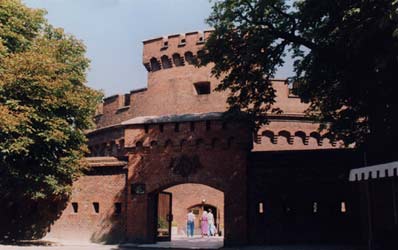 Kaliningrad is a sea port situated at the south-east coast of the Baltic sea in the mouth of the Pregel river. A former Hansa city, and at present the only ice-free Russian port at the crossing of traditional trade routes. It is considered to be a bridge to the in-ternal Russia regions, a leader in the economical transformation of Russia. Kaliningrad is a sea port situated at the south-east coast of the Baltic sea in the mouth of the Pregel river. A former Hansa city, and at present the only ice-free Russian port at the crossing of traditional trade routes. It is considered to be a bridge to the in-ternal Russia regions, a leader in the economical transformation of Russia.
Territory of Kaliningrad City - 215.7 sq. km. Population of Kaliningrad City: 423 700. The population shares according to age are: Youth - 25 %, Labor force - 51 %, Pensioners - 24 %.
Climate: annual rainfall - 600 mm, average January temperature - 2.8? C, average July temperature +17.5? C, minimum temperature - 30?, Maximum temperature + 36? C.
Indeed, in 1255 the main castle of Koenigsberg was founded on bank of the Pregel river. Since the beginning of its history, Koenigsberg actively participated in trade activities as a member of the Hanza Union. The University of Albertina was the main spiritual and cultural center of the city, which gave many impulses to the life in the city as well as to neighbors from the Baltic region.
Since World War II, the political map of Europe changed indeed and the former capital of Eastern Prussia, Koenigsberg be-came a Russian city named Kaliningrad. Today, Kaliningrad is an administrative center of the most western territory of Russia. The borders of the region were determined according to the Potsdam Conference of the Allies in 1945. One third of Eastern Prussia with capital of Koenigsberg was allocated to the former USSR and two thirds of it were attributed to Poland. The main part of the German population abandoned the territory together with the withdrawing army.
In 1946, Koenigsberg was renamed "Kaliningrad" and became an administrative center of the Kaliningrad region.
During the last years, Kaliningrad acquired new features. From the central square of the city one can see a panorama of ongo-ing construction of new housing facilities. Only the silhouette of the main cathedral built in the 14-th century reminds us of a real age of the city.
The city had lost its traditional role of bridging East and West because of the closed and limited entrance regime up to 1991 and the absence of international contacts. Nowadays, the unique geographical position of the city has become important again.
A major ice-free Baltic seaport and naval base, and an important industrial, fishing, and commercial centre, Kaliningrad has industries that produce ships, machinery, food products and process fish and wood. The city has an institute of oceanography and botanical and zoological gardens. It is the home of the Russian Baltic fleet. The city was founded (1255) as a fortress of the Teutonic Knights by King Ottocar II of Bohemia, for whom it is supposedly named. It joined (1340) the Hanseatic League and became (1457) the seat of the grand master of the Teutonic Order after the knights lost Marienburg to Poland. It was the residence of the dukes of Prussia from 1525 until the union (1618) of Prussia and Brandenburg and became (1701) the coronation city of the kings of Prussia. The Univ. of Königsberg (founded 1544) reached its greatest fame when Kant (who was born and lived his entire life at Königsberg) taught there. The university building, the 14th-cent. cathedral, and most of the old city were severely damaged by Soviet troops in World War II. The old castle was demolished after the war, and the German population was deported to Siberia. As part of the northern section of East Prussia, the city was transferred to the USSR in 1945. The new Soviet city (named Kaliningrad for Mikhail Kalinin in 1946) was laid out after 1945 in the former residential suburbs of Königsberg; its population is almost entirely Russian.
It was established historically that Kaliningrad is situated on the territory which is rich of in cultural traditions.
Kant, Bessel, Hoffman, Agnes  Migel - all these names don't need to be presented. Russian people, settled at that place after the World War II, brought another culture, permanently developing and consisting of different traditions of our multinational state. Kaliningrad can be called "a small Russian America" in the center of Europe. In the city the following theatres are available: dramatic theatre, puppet theatre, the fashion theatre of Tamara Beletskaya, some private theatres, German theatre (the only in Russia), the "Art House" (concert and theatre complex). Migel - all these names don't need to be presented. Russian people, settled at that place after the World War II, brought another culture, permanently developing and consisting of different traditions of our multinational state. Kaliningrad can be called "a small Russian America" in the center of Europe. In the city the following theatres are available: dramatic theatre, puppet theatre, the fashion theatre of Tamara Beletskaya, some private theatres, German theatre (the only in Russia), the "Art House" (concert and theatre complex).
Concerts of Russian and European organists and choir groups are held in the Organ hall of Kaliningrad Philharmonic Society.
New cinema and concert complexes equipped with modern facilities are opened in the city. The museums of Kaliningrad tell us the rich history of the region and its modern life. They are the Museum of the World Ocean, the Cathedral, the History and Art Museum, the Art Gallery, numerous monuments connected with the war history.
|













 State
State  Cities
Cities